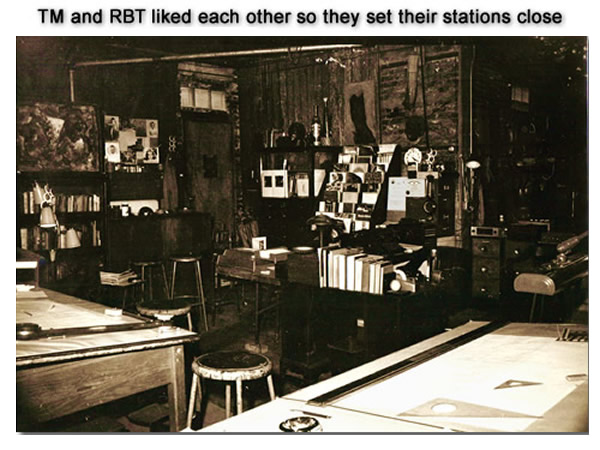|
|||||||||||
 |
 |
||||||||||
 |
 |
||||||||||
 |
 |
||||||||||
After Hours: Bob Tague and a pregnant Jan Dyer conversing, seemingly oblivious |
|||||||||||
|
|||||||||||
|
|||||||||||


Architecture: Meinecke Studios & Robert Bruce Tague C. V. Eidson Introduces Tristan Meinecke the Architect and Robert Bruce Tague Tristan Meinecke and Robert Bruce Tague met in 1960. Together they created Meinecke Studios -- Meinecke Tague Architects. They built over 800 residential units in Lincoln Park in the 60's and 70's. They contributed significantly to the modernization of this storied part of the Near-North neighborhood of Chicago. They formed their partnership in 1961 which lasted until Tague's death in 1985. Their first office was located in Meinecke's art and music studio located at 2022 N. Cleveland. (Pictures below) It opened in 1961 Prior to meeting Tague, Meinecke became interested in architecture while going over plans submitted to him by another architect. He told his wife Angel: "I can do better." She replied: "Okay, show me". Responding to her challenge, Tristan became obsessed with learning architecture; immersing himself daily in engineering / architectural textbooks and whatever other information he could find on notable architects, their works, and philosophy. Within a year he became fluent in the language of architecture and the processes and methodology behind constructing buildings. Meinecke had been building things for most of his life. He was skilled at joinery and carpentry and found many of the architectural building concepts familiar. Then he met Robert Bruce Tague and the rest is Chicago, and specifically Lincoln Park History. Meeting was fortuitous for both men. Tague was impressed with Meinecke's ideas and the short time in which he learned architecture. Meinecke was impressed with Tague's intellect and sheer volume of architectural knowledge he possessed. "Bob" was a living architectural textbook and an authority on Chicago's arcane and purposely complex building code. They shared many traits including their design philosophy patterned loosely after Frank Loyd Wright, Mies Van Der Rohe, and Moholy Nagy all of whom Tague knew personally. Additionally, they shared similar visions of how life should be lived; of how "things" should be. Their bond was deep and unique. They became fast friends, remaining so for the rest of their lives. Their period of greatest productivity saw Lincoln Park evolve from the desultory urban ghetto (a precise term) which existed prior to Mayor Richard J. Daley's Urban Renewal project of the early 60's, into a vibrant and, for the time, an unusually diverse community which contained a sizable number of creative people. Meinecke and Tague, along with other urban pioneers were at the heart of this evolution. People such as William "Bill" Hunt, who almost singlehandedly transformed Cleveland and Mohawk between Armitage and Dickens from a slum to middle-class housing, built the foundation on which the area rests today. Bill and Jan Hunt's daughter Susan Hunt created incredible beautifully meticulous paintings in a unique blend of styles and founded Hunt-Wulkowicz Graphics*. Likewise, the noted photographer Aaron Siskind lived at 2022 N. Cleveland for several years. Some of his stunning macro close-up photographs were taken on Cleveland avenue and in its ally. He could often be found in Tristan's studio talking shop. Just north on Cleveland lived James Maronek, the noted set designer for Goodman Theater. The artist Robert Nickle, another affiliate of the New Bauhaus school, had already taken up residence on the NE corner of Howe and Willow streets. The Old Town School of Folk Music was just beginning while The River Shannon on Armitage and Hudson was a popular watering hole where Tague drank frequently with Roger Ebert and other locals. Simultaneously, a group of itinerant counter-culture writers got together in the basement of Grace Lutheran Church on Geneva (now condos, but the steeple remains) and wrote the play "Grease" using local youth as models for some of the characters. The list goes on, many are not included here, but the point is there was a confluence of creative people in a small area. All left their particular mark on the neighborhood as it was being planned and developed. Their influence is still felt in 2022. To say this was an exciting time to live in Lincoln Park is an understatement. Art, music, theater, culture, and politics were all breaking new ground, and everything was happening seemingly all at once. The entire near north side was bursting with vitality and creativity. The energy was palpable and intoxicating. To Tristan Meinecke and Robert Bruce Tague, it was their neighborhood -- they had a hand in building it, and they called it home for 25 years. *Bill and Jan Hunt, and Tris and Angel Meinecke, as well as their respective children, knew each other well. Though they were friendly, Susan and Tristan were of different generations and did not interact creatively to the best of our knowledge . |
 |
|||||||||||||||||||||||||||